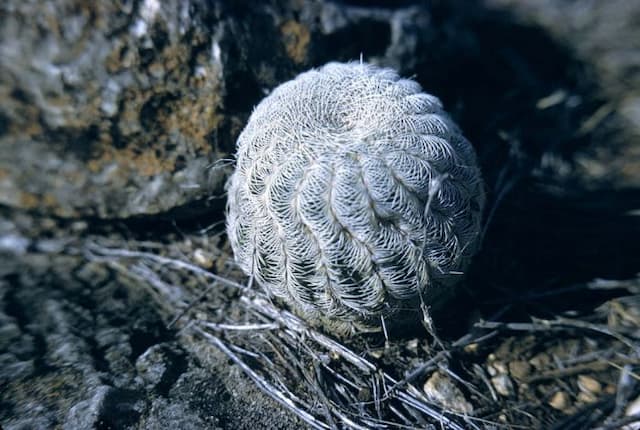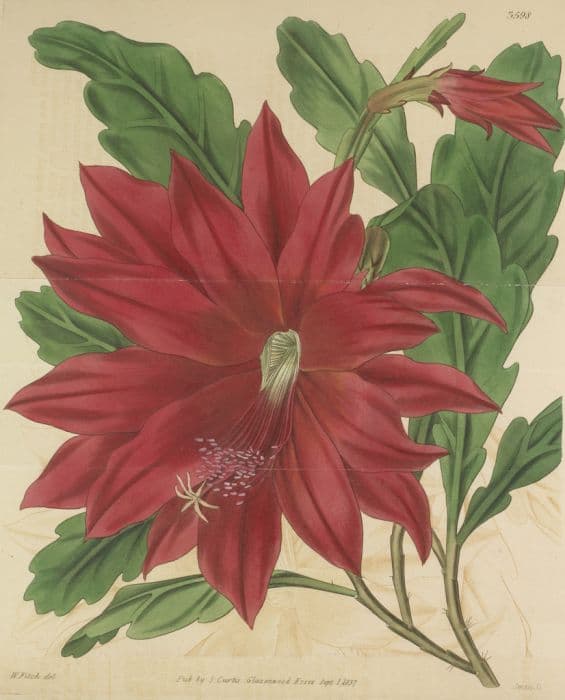Easter Lily Cactus Echinopsis oxygona

ABOUT
The Easter Lily Cactus is a visually appealing plant with a globular shape that is green to blue-green in color. Its surface is adorned with evenly spaced, protruding ribs that run vertically along its body. These ribs are lined with areoles from which long, sharp spines emerge. The spines can be yellow to brown in color, adding a contrasting touch to the greenish body of the cactus. One of the most striking features of the Easter Lily Cactus is its showy flowers. These blooms are large and funnel-shaped, and they can display a range of hues from white to various shades of pink. The petals are delicate and numerous, surrounding a central, tube-like structure. The cactus typically produces these impressive flowers in the late spring or early summer, and while they may last only for a short period, they are captivating to behold. This cactus possesses a certain architectural quality in its form, with its symmetrical and orderly spined ribs providing a textural aspect to its appearance. Although stoutly spherical when young, with time, it can develop a more elongated shape. Multiple heads may arise from the base, giving the plant a clustered look as it matures. The overall impression of the Easter Lily Cactus is one of dramatic beauty, marked by its rigid, sculptural body and its sporadic yet stunning floral displays.
About this plant
 Names
NamesFamily
Cactaceae.
Synonyms
Easter Lily Cactus, Night Blooming Hedgehog, Sea-Urchin Cactus, Star Cactus, Pink Easter Lily Cactus.
Common names
Cereus oxygonus, Echinocactus oxygonus, Echinopsis multiplex, Cereus multiplex.
 Toxicity
ToxicityTo humans
Easter Lily Cactus (Echinopsis oxygona) is not generally considered to be toxic to humans. There are no widespread reports of poisoning or severe reactions from ingesting this plant. While it may cause mild gastrointestinal discomfort if ingested due to its fibrous plant material, it does not contain potent toxins that are known to cause serious harm to humans.
To pets
Easter Lily Cactus (Echinopsis oxygona) is also not regarded as toxic to pets. Much like with humans, ingestion of this plant may result in mild gastrointestinal upset due to the physical nature of the plant material, but it does not contain substances that are known to be significantly toxic to animals. However, it is always advisable to prevent pets from ingesting plants, as individual reactions can vary.
 Characteristics
CharacteristicsLife cycle
Perennials
Foliage type
Evergreen
Color of leaves
Green
Flower color
Pink
Height
6 inches (15 cm)
Spread
6 inches (15 cm)
Plant type
Cactus
Hardiness zones
9
Native area
South America
Benefits
 General Benefits
General Benefits- Ornamental Value: Echinopsis oxygona, commonly known as Easter Lily Cactus, is prized for its showy, fragrant flowers that add aesthetic appeal to gardens and indoor spaces.
- Drought Tolerant: As a cactus, it is highly adapted to dry conditions, requiring minimal watering and care, making it a suitable choice for xeriscaping.
- Easy Propagation: Easter Lily Cactus can be easily propagated from offsets, allowing gardeners to multiply their collection and share with others.
- Fast Growth: Compared to many other cacti, Echinopsis oxygona has a relatively fast growth rate, providing quick gratification for growers.
- Pollinator Attraction: The flowers of the Easter Lily Cactus attract bees and other pollinators, supporting local ecosystems.
 Medical Properties
Medical PropertiesThis plant is not used for medical purposes.
 Air-purifying Qualities
Air-purifying QualitiesThis plant is not specifically known for air purifying qualities.
 Other Uses
Other Uses- Easter Lily Cactus can be used as a natural barrier when planted in clusters, due to its spiky body deterring animals and intruders.
- The flowers of the Easter Lily Cactus are used in the production of certain perfumes, taking advantage of their strong, pleasant fragrance.
- In artistic contexts, the unique spherical structure and striking flowers of Easter Lily Cactus are often used as subjects in photography and botanical illustration.
- Dried Easter Lily Cactus flowers are sometimes incorporated into potpourri mixes, providing visual diversity and retaining a mild scent.
- These cacti are used in education, specifically botany and horticulture, as examples to teach about desert plant adaptations and reproductive strategies.
- The geometric patterns of the Easter Lily Cactus's ribs and areoles are sometimes studied or replicated in the field of biomimicry for design inspiration.
- The plant's ability to store water can be examined in sustainability studies, looking at how desert plants manage resources in arid environments.
- During Easter, the Easter Lily Cactus is sometimes given as a gift in certain cultures, symbolizing resurrection and new beginnings associated with the holiday.
- Enthusiasts of Feng Shui sometimes use Easter Lily Cactus, placing them in specific areas of the home to add 'wood energy' and promote balance.
- In craft projects, the stiff, fallen spines of the Easter Lily Cactus may be collected and used as natural sewing needles or for making miniature decorations.
Interesting Facts
 Feng Shui
Feng ShuiThe Easter Lily Cactus is not used in Feng Shui practice.
 Zodiac Sign Compitability
Zodiac Sign CompitabilityThe Easter Lily Cactus is not used in astrology practice.
 Plant Symbolism
Plant Symbolism- Resilience: Echinopsis oxygona, commonly known as Easter Lily Cactus, can survive in harsh conditions and symbolizes the ability to endure challenges.
- Beauty in harshness: Despite its spiky exterior, the Easter Lily Cactus produces beautiful flowers, representing the concept that beauty can be found in the most unexpected places.
- Awakening: The Easter Lily Cactus typically blooms around Easter, a time often associated with rebirth and new beginnings, making it a symbol of awakening and hope.
- Protection: The cactus's thorns can be seen as protective armor, making it a symbol of personal space and self-defense.
- Adaptation: As a plant that can adjust to less-than-ideal circumstances, the Easter Lily Cactus exemplifies adaptability and the ability to thrive in various environments.
 Water
WaterEaster Lily Cactus, also known as Echinopsis oxygona, should be watered regularly during the growing season, typically from spring to fall, ensuring the soil is allowed to dry out slightly between waterings. You might water it every 7-10 days, providing around 16-24 ounces depending on the pot size and environmental conditions. In winter, reduce watering to about once a month or when the soil is completely dry, to mirror its native dormant period.
 Light
LightEaster Lily Cactus thrives in bright, indirect sunlight and can tolerate some direct morning light. The ideal spot would be a well-lit room or near a window with filtered light to prevent sunburn. Avoid exposing it to the harsh afternoon sun, which can be too intense and may damage the plant.
 Temperature
TemperatureThe Easter Lily Cactus prefers temperatures between 50 and 85 degrees Fahrenheit. It should be protected from frost, as it can only tolerate temperatures down to about 40 degrees Fahrenheit. The ideal temperature range for this cactus is between 70 and 80 degrees Fahrenheit to promote healthy growth.
 Pruning
PruningEaster Lily Cactus typically does not require frequent pruning, but it may benefit from the removal of any dead or damaged growth to maintain its appearance. Pruning should be done after the blooming season or as needed to remove spent flowers and to shape the plant if desired.
 Cleaning
CleaningAs needed
 Soil
SoilEaster Lily Cactus thrives in a well-draining soil mix comprising one part potting soil, one part coarse sand, and one part perlite or pumice. The ideal soil pH should be slightly acidic to neutral, ranging from 6.0 to 7.5.
 Repotting
RepottingThe Easter Lily Cactus should be repotted every two to three years or when it outgrows its pot. Ensure to use a well-draining soil mix during repotting.
 Humidity & Misting
Humidity & MistingEaster Lily Cactus prefers low to moderate humidity levels, as it is accustomed to arid environments. Ideal humidity should be between 10% and 30%.
 Suitable locations
Suitable locationsIndoor
Place in bright, indirect light with good air circulation.
Outdoor
Full sun to partial shade; protect from extreme cold.
Hardiness zone
8-11 USDA
 Life cycle
Life cycleThe Echinopsis oxygona, commonly known as the Easter Lily Cactus, begins its life cycle as a seed that germinates in optimal conditions of warmth and moisture. Upon sprouting, the seedling develops into a small cactus with a spherical shape and starts to exhibit ribbed bodies and areoles from which spines and flowers will emerge. As it matures, the cactus grows wider and may produce offsets or "pups" around its base, which can be detached to propagate new plants. The Easter Lily Cactus reaches sexual maturity and begins producing large, nocturnal, funnel-shaped flowers mainly in spring or early summer, which are typically white to pale pink and highly fragrant. After pollination, which is often facilitated by night-flying insects such as moths, the flowers develop into fruit containing seeds, thus completing the reproductive cycle. Over many years, with the right care and conditions, Echinopsis oxygona can reach up to around 8 inches in height and continue to flower annually, contributing to the next generation of cacti through its seeds.
 Propogation
PropogationPropogation time
Spring-Early Summer
Echinopsis oxygona, commonly known as the Easter Lily Cactus, is best propagated through offsets, which typically are produced abundantly around the base of the parent plant. The optimal time for propagating this cactus is during its active growing period, which is in the spring and early summer. To propagate, one should gently remove the offsets from the main plant using a clean, sharp knife or by twisting them off by hand. It is important to allow the offsets to dry and form a callous for a few days before planting. Once calloused, plant the offsets in a well-draining cactus mix, positioning them just deep enough to stand upright. Water lightly to settle the soil around the offsets and resume regular watering once the offsets have established roots, which usually takes several weeks. This method is favored for its simplicity and effectiveness in producing new, independent plants that resemble the parent.








